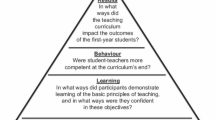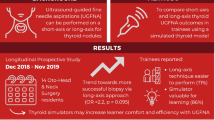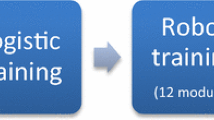Abstract
Background
Bilateral axillo-breast approach robotic thyroidectomy (BABA RT) is an excellent surgical method, being oncologically safe and with anatomic views similar to those of open surgery. BABA RT, however, requires training and a learning curve for proficiency. We evaluated the educational effectiveness of a surgical training model for BABA RT, comparing objective BABA scores with scores on the da Vinci Skills Simulator (dVSS).
Methods
Medical students, surgical residents, and surgical fellows performed structured tasks with the BABA training model and dVSS under the same conditions. All tasks were videotaped. BABA scores were compared with dVSS scores and with objective evaluation scores (GEARS and OSATS).
Results
Eight medical students, ten surgical residents, and eight surgical fellows participated in this study. The educational effect of BABA training improved from one to two (p < 0.001), two to three (p = 0.003), and one to three (p < 0.001) procedures. Statistically significant differences were found when students were compared with residents (p = 0.025) and fellows (p < 0.001) in the BABA training model, and between students and fellows (p = 0.004) in dVSS. BABA scores showed similar distribution patterns in the three groups to GEARS and OSATS scores (p < 0.001 each).
Conclusions
The BABA training model is an excellent educational tool for surgical residents and surgical fellows to learn and practice BABA RT. Assessment by BABA score yielded objective results comparable to those of traditional scoring methodologies.




Similar content being viewed by others
References
Lang BH, Wong CK, Tsang JS, Wong KP, Wan KY (2015) A systematic review and meta-analysis evaluating completeness and outcomes of robotic thyroidectomy. Laryngoscope 125:509–518. doi:10.1002/lary.24946
Lee KE, Kim E, Koo DH, Choi JY, Kim KH, Youn YK (2013) Robotic thyroidectomy by bilateral axillo-breast approach: review of 1026 cases and surgical completeness. Surg Endosc Other Interv Tech 27:2955–2962. doi:10.1007/s00464-013-2863-1
Lee KE, Choi JY, Youn YK (2011) Bilateral axillo-breast approach robotic thyroidectomy. Surg Laparosc Endosc Percutan Tech 21:230–236. doi:10.1097/SLE.0b013e31822d0455
Lee KE, do Koo H, Im HJ, Park SK, Choi JY, Paeng JC, Chung JK, Oh SK, Youn YK (2011) Surgical completeness of bilateral axillo-breast approach robotic thyroidectomy: comparison with conventional open thyroidectomy after propensity score matching. Surgery 150:1266–1274. doi:10.1016/j.surg.2011.09.015
Kim WW, Jung JH, Park HY (2015) The learning curve for robotic thyroidectomy using a bilateral axillo-breast approach from the 100 cases. Surg Laparosc Endosc Percutan Tech 25:412–416. doi:10.1097/sle.0000000000000121
Jiam NT, Cooper MA, Lyu HG, Hirose K, Majary MA (2014) Surgical malpractice claims in the United States. J Healthc risk Manag 33:29–34. doi:10.1002/jhrm
Narayanan SK, Cohen RC, Shun A (2014) Technical tips and advancements in pediatric minimally invasive surgical training on porcine based simulations. Pediatr Surg Int 30:655–661. doi:10.1007/s00383-014-3502-1
Gravante G, Venditti D (2013) A systematic review on low-cost box models to achieve basic and advanced laparoscopic skills during modern surgical training. Surg Laparosc Endosc Percutan Tech 23:109–120. doi:10.1097/SLE.0b013e3182827c29
Finnerty BM, Afaneh C, Aronova A, Fahey TJ, Zarnegar R (2016) General surgery training and robotics: are residents improving their skills? Surg Endosc Other Interv Tech 30:567–573. doi:10.1007/s00464-015-4240-8
Asch DA, Nicholson S, Srinivas S, Herrin J, Epstein AJ (2009) Evaluating obstetrical residency programs using patient outcomes. JAMA 302:1277–1283. doi:10.1001/jama.2009.1356
Kiely DJ, Gotlieb WH, Lau S, Zeng X, Samouelian V, Ramanakumar AV, Zakrzewski H, Brin S, Fraser SA, Korsieporn P, Drudi L, Press JZ (2015) Virtual reality robotic surgery simulation curriculum to teach robotic suturing: a randomized controlled trial. J Robot Surg 9:179–186. doi:10.1007/s11701-015-0513-4
Liss MA, Abdelshehid C, Quach S, Lusch A, Graversen J, Landman J, McDougall EM (2012) Validation, correlation, and comparison of the da Vinci trainer(™) and the daVinci surgical skills simulator(™) using the Mimic(™) software for urologic robotic surgical education. J Endourol 26:1629–1634. doi:10.1089/end.2012.0328
Goh AC, Goldfarb DW, Sander JC, Miles BJ, Dunkin BJ (2012) Global evaluative assessment of robotic skills: validation of a clinical assessment tool to measure robotic surgical skills. J Urol 187:247–252. doi:10.1016/j.juro.2011.09.032
Martin JA, Regehr G, Reznick R, Macrae H, Murnaghan J, Hutchison C, Brown M (1997) Objective structured assessment of technical skill (OSATS) for surgical residents. Br J Surg 84:273–278. doi:10.1002/bjs.1800840237
Waran V, Narayanan V, Karuppiah R, Pancharatnam D, Chandran H, Raman R, Rahman ZA, Owen SL, Aziz TZ (2014) Injecting realism in surgical training - initial simulation experience with custom 3D models. J Surg Educ 71:193–197. doi:10.1016/j.jsurg.2013.08.010
Evgeniou E, Loizou P (2013) Simulation-based surgical education. ANZ J Surg 83:619–623. doi:10.1111/j.1445-2197.2012.06315.x
Davies J, Khatib M, Bello F (2013) Open surgical simulation - a review. J Surg Educ 70:618–627. doi:10.1016/j.jsurg.2013.04.007
Santos BF, Enter D, Soper NJ, Hungness ES (2011) Single-incision laparoscopic surgery (SILS) versus standard laparoscopic surgery: a comparison of performance using a surgical simulator. Surg Endosc Other Interv Tech 25:483–490. doi:10.1007/s00464-010-1197-5
Chai YJ, Suh H, Woo JW, Yu HW, Song RY, Kwon H, Lee KE (2016) Surgical safety and oncological completeness of robotic thyroidectomy for thyroid carcinoma larger than 2 cm. Surg Endosc. doi:10.1007/s00464-016-5097-1
Hashimoto T, Yoshioka K, Gondo T, Kamoda N, Satake N, Ozu C, Horiguchi Y, Namiki K, Nakashima J, Tachibana M (2013) Learning curve and perioperative outcomes of robot-assisted radical prostatectomy in 200 initial Japanese cases by a single surgeon. J Endourol 27:1218–1223. doi:10.1089/end.2013.0235
Napoli N, Kauffmann EF, Palmeri M, Miccoli M, Costa F, Vistoli F, Amorese G, Boggi U (2016) The learning curve in robotic pancreaticoduodenectomy. Dig Surg 33:299–307. doi:10.1159/000445015
De Win G, Van Bruwaene S, Kulkarni J, Van Calster B, Aggarwal R, Allen C, Lissens A, De Ridder D, Miserez M (2016) An evidence based laparoscopic simulation curriculum shortens the clinical learning curve and reduces surgical adverse events. Adv Med Educ Pract 7:357–370. doi:10.2147/AMEP.S102000
Bareeq RA, Jayaraman S, Kiaii B, Schlachta C, Denstedt JD, Pautler SE (2008) The role of surgical simulation and the learning curve in robot-assisted surgery. J Robot Surg 2:11–15. doi:10.1007/s11701-008-0074-x
Aghazadeh MA, Jayaratna IS, Hung AJ, Pan MM, Desai MM, Gill IS, Goh AC (2015) External validation of global evaluative assessment of robotic skills (GEARS). Surg Endosc 29:3261–3266. doi:10.1007/s00464-015-4070-8
Acknowledgements
This research was supported by Basic Science Research Program through the National Research Foundation of Korea (NRF) funded by the Ministry of Science, ICT & Future Planning, Republic of Korea (Grant Number: 2015R1C1A1A01055464).
Author information
Authors and Affiliations
Corresponding author
Ethics declarations
Disclosures
Hyeong Won Yu, Jin Wook Yi, Chan Yong Seong, Jong-kyu Kim, In Eui Bae, Hyungju Kwon, Young Jun Chai, Su-jin Kim, June Young Choi, and Kyu Eun Lee have no conflicts of interest or financial ties to disclosure.
Rights and permissions
About this article
Cite this article
Yu, H.W., Yi, J.W., Seong, C.Y. et al. Development of a surgical training model for bilateral axillo-breast approach robotic thyroidectomy. Surg Endosc 32, 1360–1367 (2018). https://doi.org/10.1007/s00464-017-5816-2
Received:
Accepted:
Published:
Issue Date:
DOI: https://doi.org/10.1007/s00464-017-5816-2




